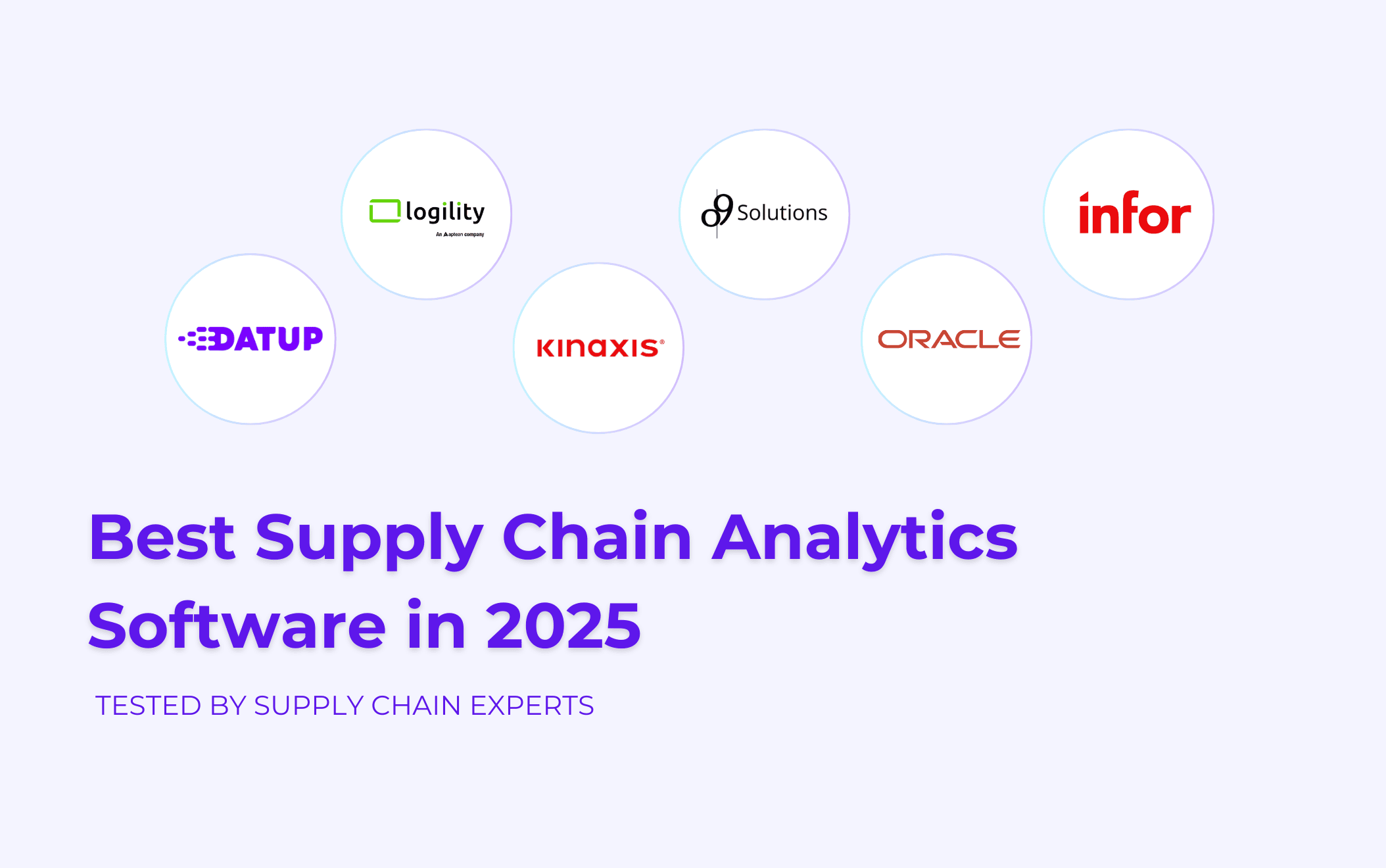The best supply chain collaboration software are: Datup, SAP, Coupa, Relex, Kinaxis, Oracle and Blue Yonder.
Choosing the best one for your company depends on your needs and characteristics, which is why we have researched in detail every collaboration tool in the supply chain so that you can choose your own.
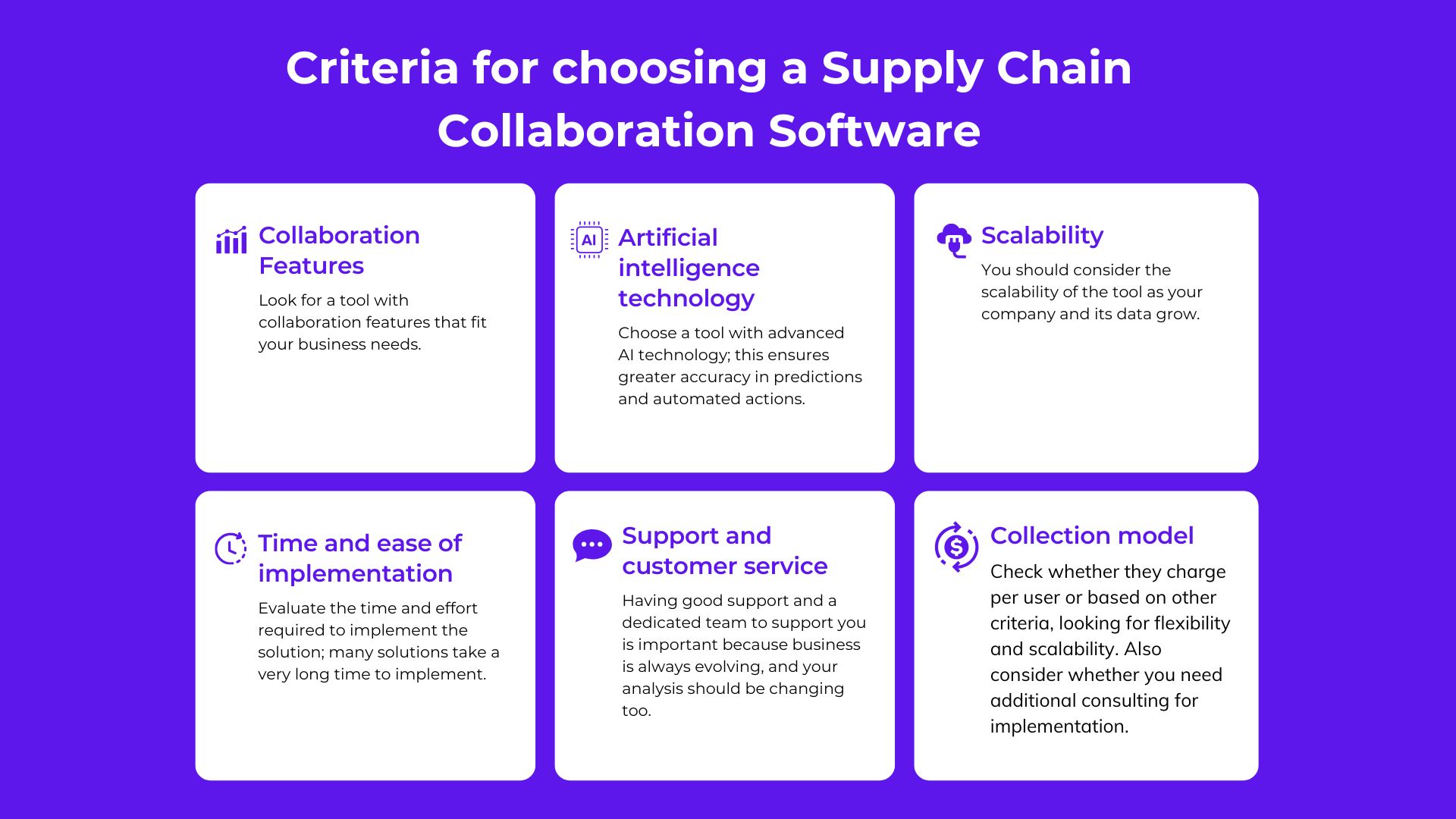
What to consider when choosing a supply chain collaboration software solution?
There are different factors to take into consideration, choosing a Supply Chain Collaboration Software should be a task designed based on the needs of your company and the objectives you want to achieve with it. Here are the most important ones in 2025:
1. Collaboration features
Collaboration is at the core of this tool. The functionalities to work together must go beyond sharing the same forecast: they must include multicollaboration between different areas, collaborative visibility of the planning process and clear comparison between reality and what is expected, so that the workflow between different departments is fluid and interconnected.
2. Scalability
You should consider the Scalability of the tool as your company grows and with it your data. It ensures that when making acquisitions, new product launches, market expansions and more, the software is able to process this data perfectly, ensuring the correct forecasts. Nowadays, a tool that has its data structure in the cloud is.
3. User Friendly and Learning Curve
Un user friendly design helps you to adopt the software more quickly. The software should have an intuitive interface and an average learning curve. A clear design, contextual menus and interactive guides make it easy to onboard users, from planners to logistics and marketing managers.
4. Vendors Support and Customer Service
Customer service is more important today. In tools with robust data implementation, it is always good to consider the assistance of teams, since there may be situations where specific metrics or new data are needed to be incorporated. Therefore, we recommend that you check the support channels (email, chat, WhatsApp, etc.), their availability and training resources such as tutorials and webinars.
5. Artificial intelligence technology
Incorporating Artificial Intelligence into your supply chain is the new normal. With AI you can have specialized conversational assistants In Supply Chain, accurate demand forecasts, intelligent suggested inventory optimization, risk anticipation and more, therefore, it details what machine learning functionalities the tool has before hiring it.
Datup supply chain collaboration software: our 2025 choice
Datup is a software specialized in Supply Chain Collaboration with Artificial Intelligence that has modules of demand planning, inventory management, purchasing and sales, collaboration between areas and a conversational assistant with AI that helps you in your decisions in your supply chain. If your company bills more than 10 million dollars annually and needs AI-based Supply Chain Collaboration software, Datup is your best option.
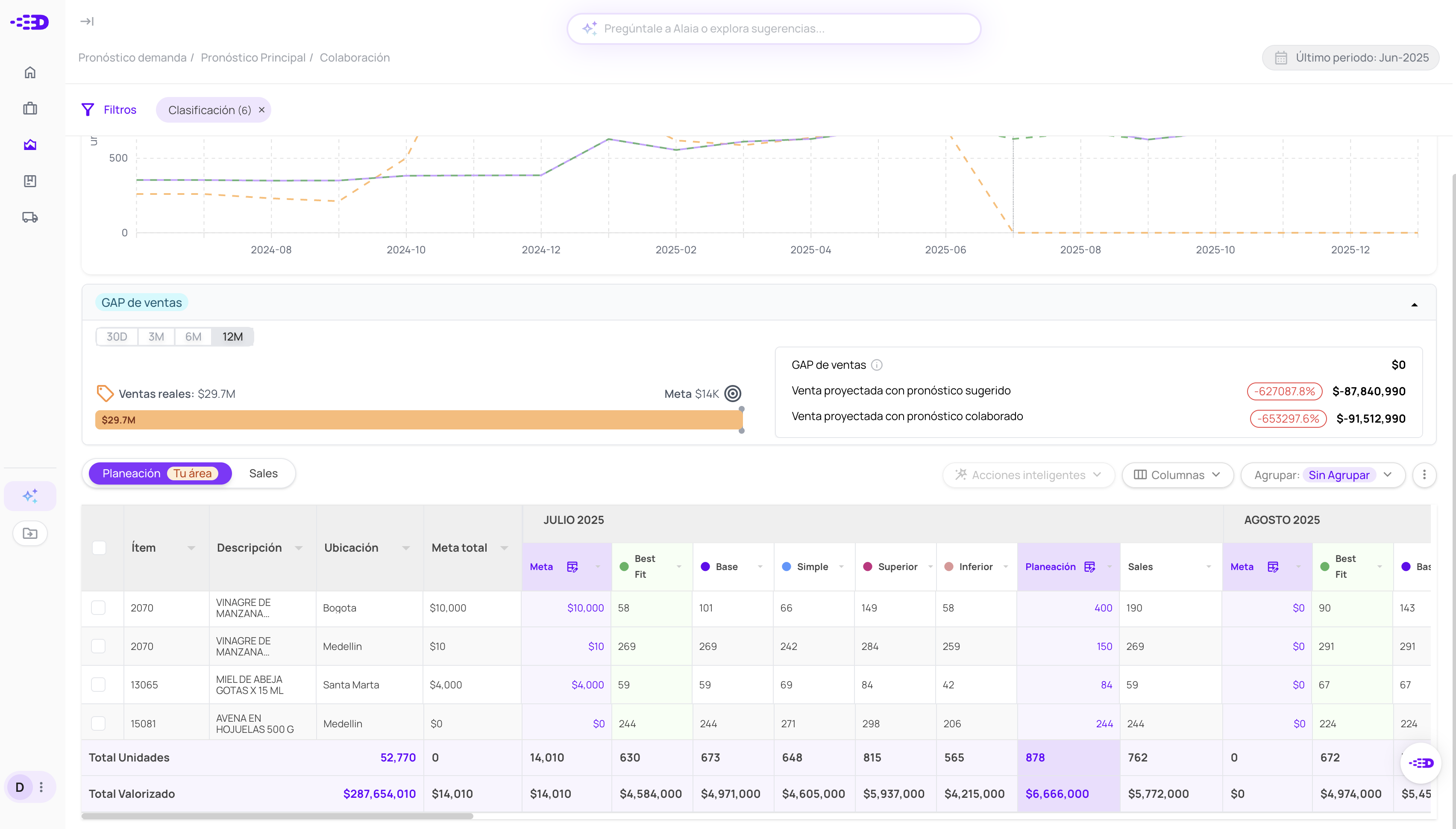
Datup features and pros
- Actionable demand forecasting: Demand planning that takes into account all links in the supply chain, also generates intelligent purchasing recommendations, taking into account supplier policies and leadtimes.
- Optimized inventory management with AI: It has intelligent inventory classification and management that automatically adjusts reorder points, safety stock and real delivery times.
- Multicollaboration of teams module: across multiple areas you can collaborate and manage with interactive filters, collaborative comments, team goals, and more.
- Focused on real-time operational decisions: It delivers dynamic scenarios and simulation to anticipate risks, opportunities and collaborations.
- Integrate external variables: such as geopolitical conditions, climate and changes in regulations.
- Conversational assistant with AI: you can have a trained assistant (AlaiA) with information about your supply chain, who specializes in Supply Chain and will help you with your day-to-day operations.
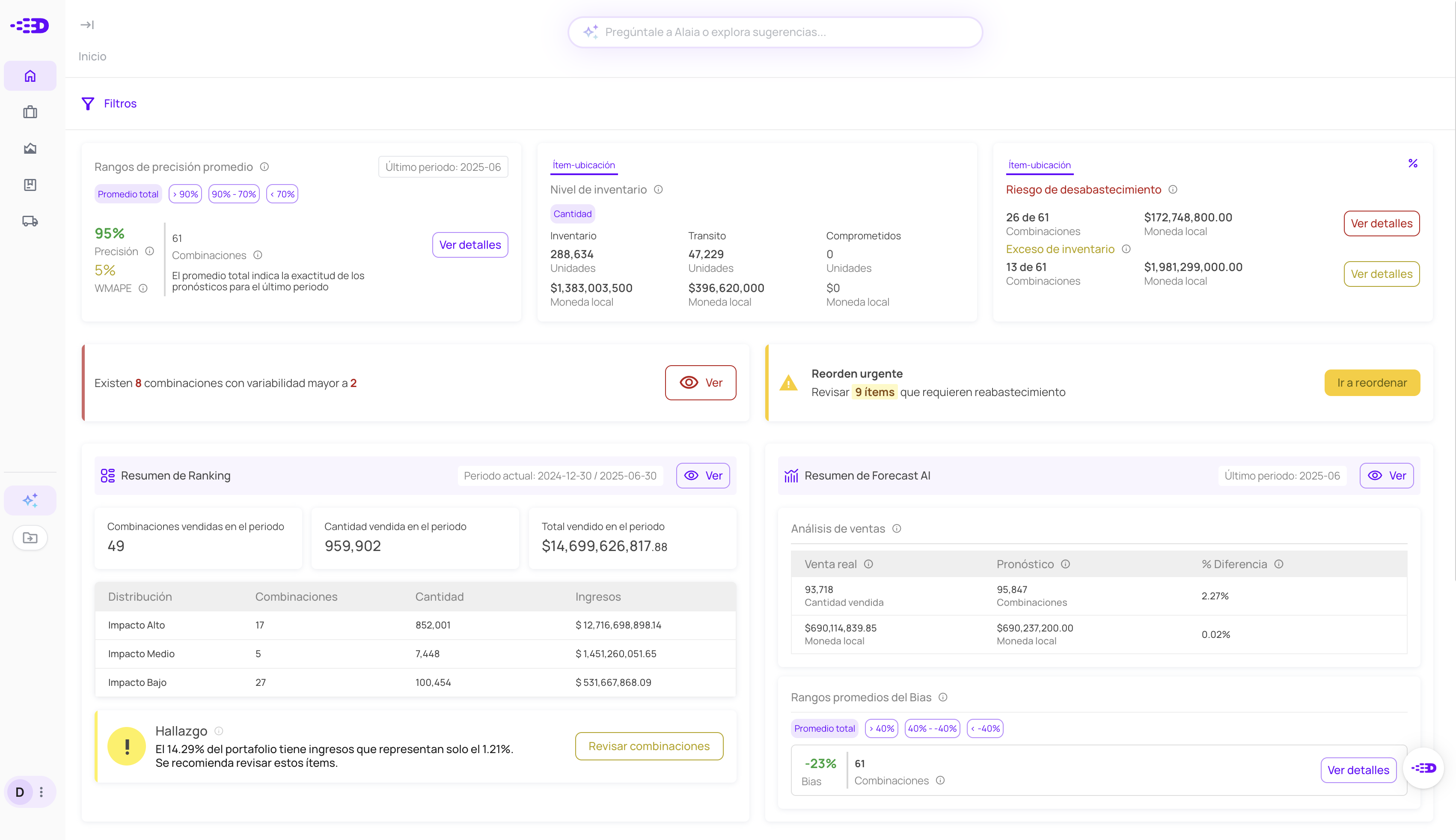
Datup Benefits
- Demand forecasts considering external variables: Datup provides dynamic forecasting scenarios which can consider external variables that affect the operation: inflation, climate, etc.
- Collaborative forecasting and decision-making panel: Datup has the Collab module, which accelerates collaboration in up to 4 key areas, consolidating information in a single panel and graph, giving visibility to the planner to validate and plan the following periods.
- Demand forecasts for new products: You can forecast for new products with no history, using data from similar products. This is not allowed by traditional ERPs.
- Easy to learn and intuitive interface: Datup is designed for easy and intuitive use, being a simple tool for Analysts, Managers, CEOs, CFOs and other non-technical personnel.
- Optimized portfolio classification: Datup automatically classifies the product portfolio according to its impact on the business, which speeds up inventory prioritization and quick decision-making.
- Inventory reorders with smart actions: Datup's reorder module generates automatic purchase recommendations based on real demand, available stock and supplier delivery time. The platform analyzes this data to suggest what, how much and when to replace, without the need for spreadsheets or manual calculations
- Customization and parameterization based on business rules: how to define security stocks, capacities, inventory policies and business agreements, to adapt to the specific needs of each company.
- Implementation on average in 5 weeks: it is one of the fastest on the market thanks to weeks. ERPs and other systems take months or even years to implement.
- Affordable subscription pricing: charging a base rate regardless of the number of users. Others charge per user, becoming very expensive.
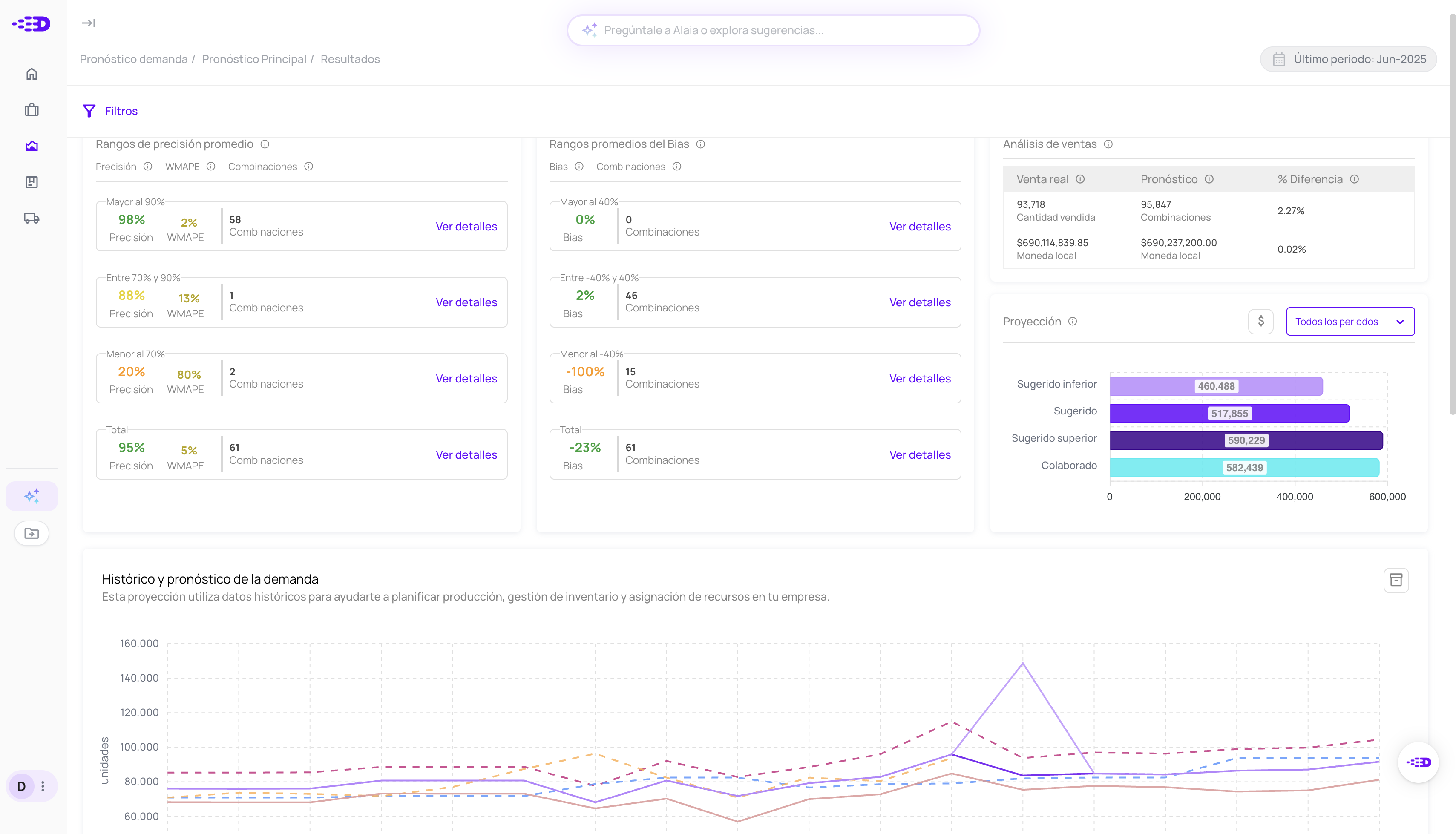
Datup's solutions for supply chain equipment include:
- Supply Chain Collaboration Software
- Demand planning software
- Inventory and Purchasing Management Software
- Portfolio optimization software
- AlAia: conversational assistant with AI, specially trained for your business
Disadvantages
- The business must have data of at least 2 years in order for forecasts to be as accurate as possible.
- Datup doesn't work for small businesses that make less than 10 M USD per year.
- It requires an internet connection to work.
Implementation process
- Implementation is fast, taking weeks instead of months. Datup does the integration.
- It's a SaaS, it doesn't require servers or customer infrastructure. Only access to databases.
- It requires a minimum of 2 years of historical data in the customer's ERP to make 1-year forecasts.
- It has a customer success team dedicated to supporting the customer.
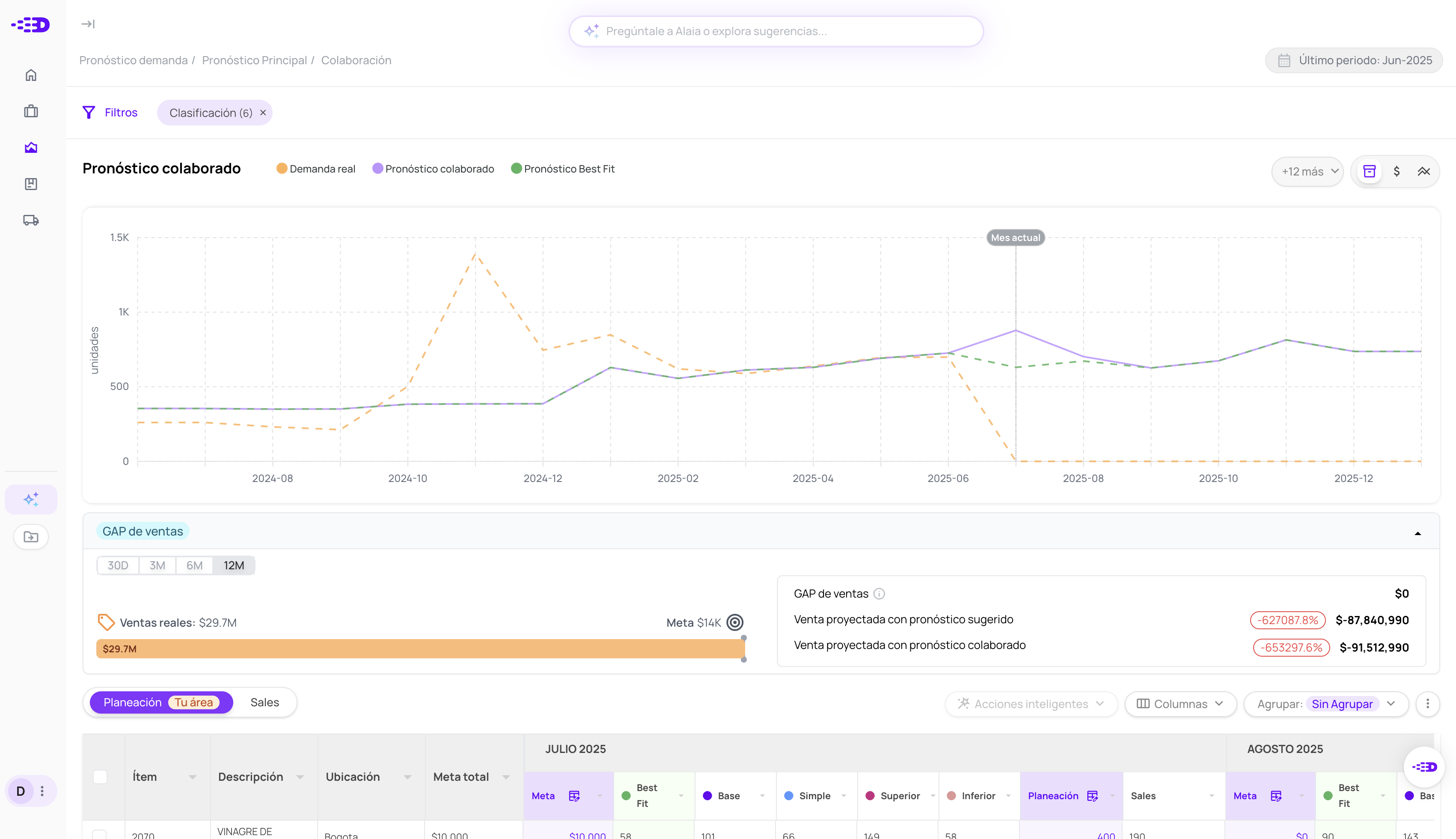
Is Datup the best supply chain collaboration software for your company?
Datup has features such as demand forecasting, Collaboration Panel and Collaborative Forecasting, Intelligent AI-based recommendations conversational assistant specialized in Supply Chain Management, and many more.
If you are looking for a robust and modern collaboration process, powered by AI, Datup is the best option for your company.
Datup is ideal for:
- Companies that bill at least USD 10M per year.
- Companies with a structured ERP, with a minimum of 2 years of history.
- Companies that want to do advanced predictive and prescriptive analytics, beyond basic descriptive reports.
- Companies that need to automate their supply chain operational processes with AI without hiring extra technical staff.
- Companies that need a centralized source of truth with data from multiple systems.
- Organizations that value rapid deployment and customized dashboards: With an average implementation time of 5 weeks, Datup connects to your data, processes it in the cloud and provides dashboards adapted to your needs.
SAP supply chain collaboration software
SAP is a platform that connects the links of the supply chain in a single tool (suppliers, manufacturers, distributors and customers). It stands out for its ability to integrate data for collaborative decision-making, giving full visibility to the supply chain for agile decision-making and reducing disruptions.
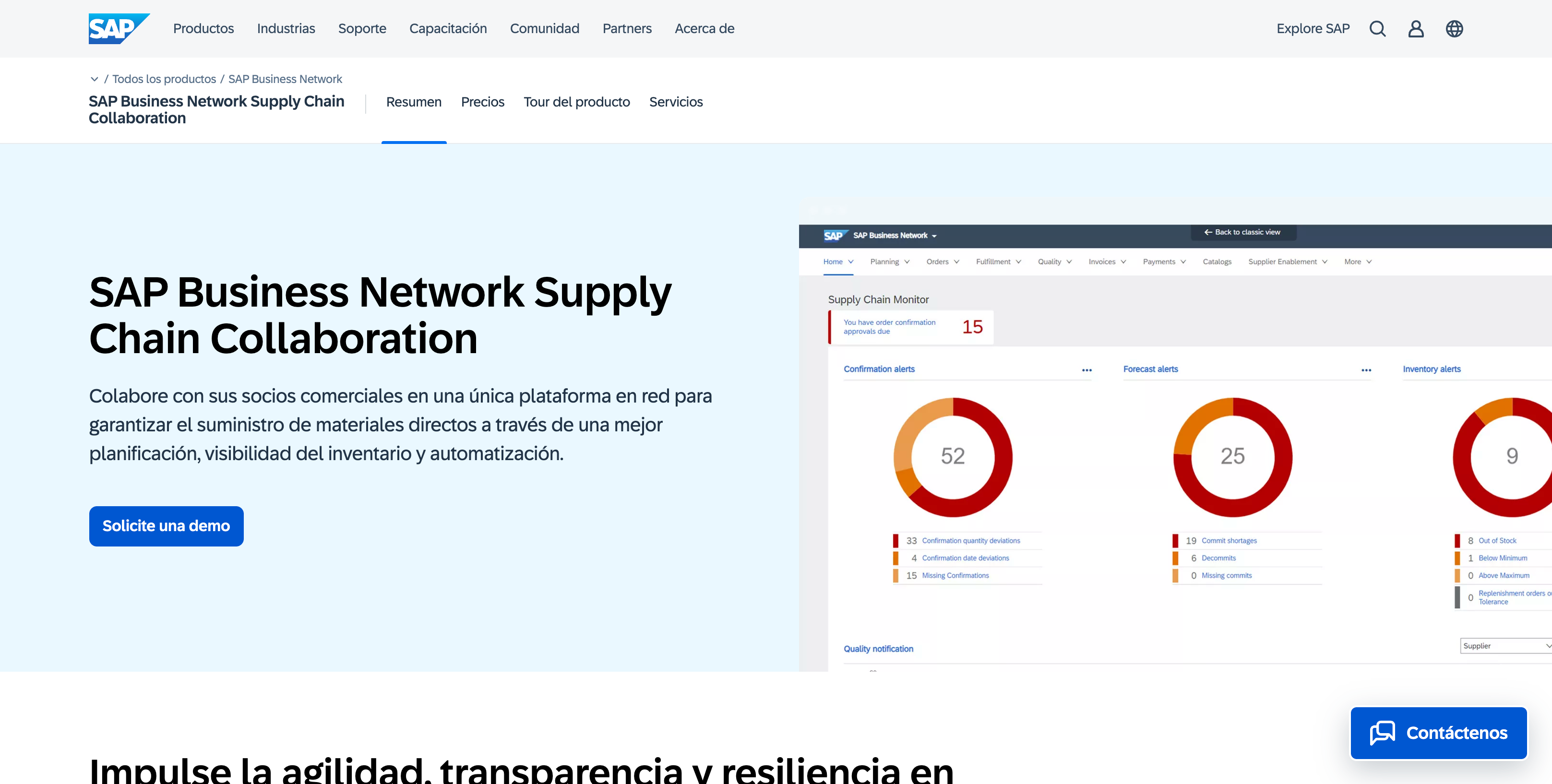
The price of SAP is not publicly available, its model works by annual subscription, with blocks of use according to the estimated expense and automatic renewal, therefore, the price may vary depending on the size and approach of the solutions.
Benefits and features of SAP Business Network Supply Chain Collaboration
- Collaboration on projections: visibility of forecasts and commitment alerts to act before problems arise
- Collaboration in procurement: send digital orders, receive confirmations and follow up in transit to ensure timely deliveries
- Inventory collaboration: manages inventory under the VMI model and uses delivery plans to maintain optimal levels
- Quality collaboration: detects problems and complaints in time, standardises documentation and speeds up inspections
- Manufacturing collaboration: synchronizes multiple levels of suppliers and controls strategic components to prevent supply gaps
- Higher Efficiency and Shorter Cycles thanks to the automation of repetitive tasks and approvals, allowing teams to work from anywhere with clear digitized steps.
In the words of their customers:
“It has several functions, such as notifications to providers and the function of downloading and uploading files, which saves providers a lot of time. Sending the upload file via email reduces the load even more.” SAP SCC client, 2022.
Disadvantages of SAP
- High cost: SAP is one of the most expensive tools in the market, and it can increase depending on the solutions you want in your company.
- Complexity of use: the SAP interface can become unfriendly to new users, causing slowness in its first uses and a steep learning curve
- Slow and complex implementation: setting up a tool such as SAP takes time since it is a standardized process done by specialists, and the integration of advanced or customized functions can take even longer.
- Dependency on specialized technical personnel: it is necessary to have personnel specialized in SAP to carry out the use of the tool, which increases the costs of trained technical personnel.
- Updates and maintenance: SAP requires constant updates, and it can be costly and complex to implement.
In the words of their customers:
“SAP is not defining its future scope/improvements and is intentionally removing it” SAP SCC client, 2022.
Is SAP the best supply chain collaboration tool for your company?
SAP Supply Chain Collaboration is a robust solution designed for companies that need to manage complex supply chains, with multiple actors and high operational requirements. It's ideal for companies with:
- With global supply chain and multiple partners
- High volume of operations and transactions
However, you should take into consideration:
- It is a platform with high implementation and maintenance costs.
- You will need personnel specialized in SAP because of its complexity.
- The initial implementation is slow and complex.
Relex supply chain collaboration solution
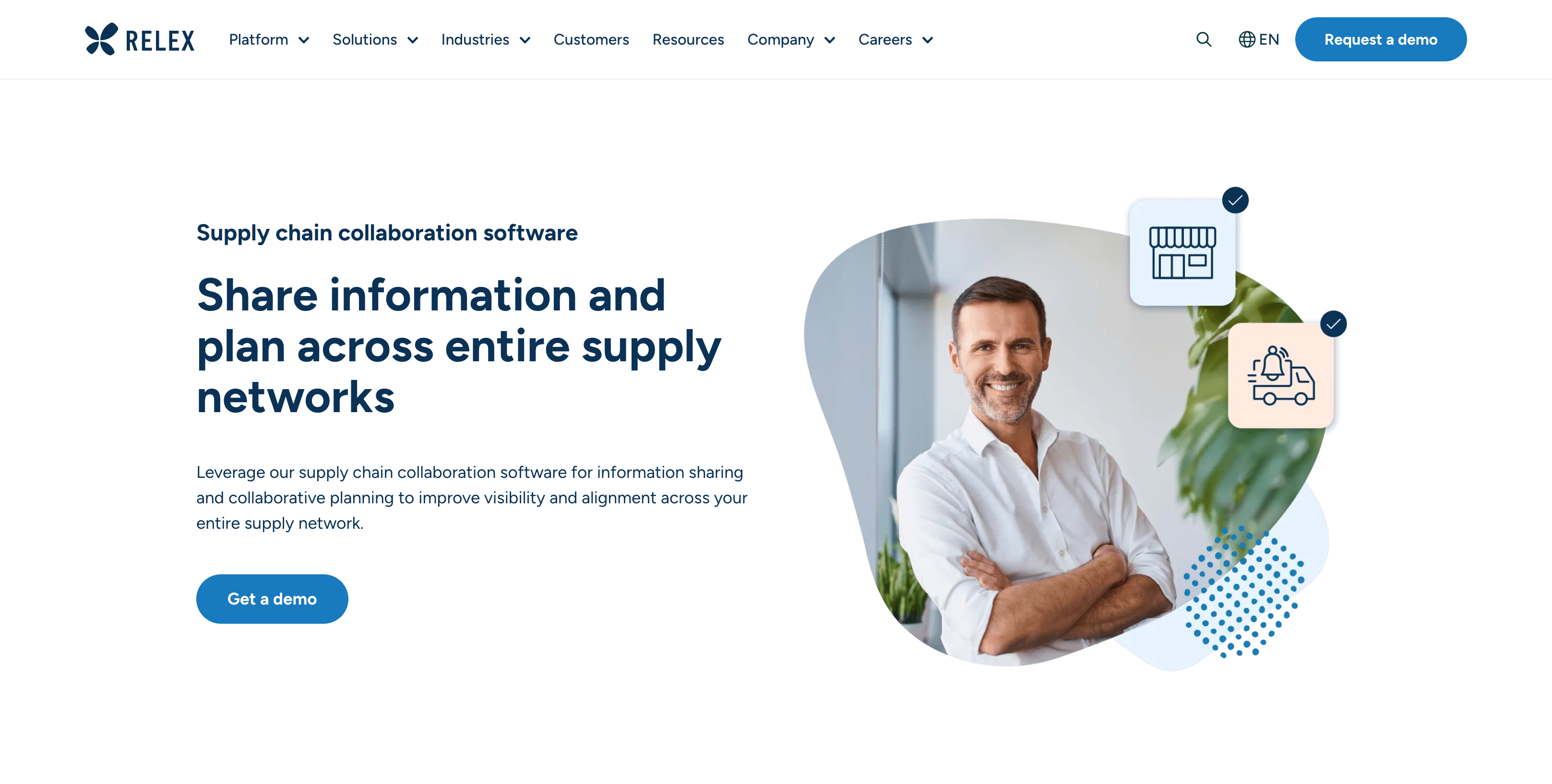
RELEX Supply Chain Collaboration Solution is a platform designed to optimize supply chain collaboration: retailers, suppliers, manufacturers and distributors. Its objective is to improve visibility, operational efficiency and sustainability, allowing information to be shared in real time and to make decisions based on data to anticipate demand and reduce costs.
It stands out for being a pioneer in collaboration solutions in supply networks validated by independent analysts, highlighting its innovation, vision, capacity for restriction-based planning, collaboration in forecasts and multilevel visibility.
The price of Relex is not public and requires a personalized quote, as factors such as:
- Volume of data and managed transactions.
- Number of users and locations.
- Required modules and functionalities.
- Level of customization, integration and technical support.
What your customers are saying:
“Fast performance, constant flow of new features and, above all, customization to your liking. Smooth implementation and compatibility with other tools thanks to the best technical standards.” Relex customer, 2024.
Differentiating features of Relex
- Real-time collaboration: the different teams share forecasts, inventories and sales from the same interface, allowing us to adjust production and supply in an agile way.
- Intelligent automation: Replenishment, order management and inventory planning optimized with advanced algorithms.
- Digital twin and simulations: Simulated scenarios that allow us to anticipate disruptions, optimize capacity and minimize stock breakages.
- Scalable and configurable: Cloud-native platform adaptable to the needs of each operation, without custom developments.
- Integrated sustainability: It helps reduce waste (especially in perishable foods) and improves the operation's environmental KPIs.
In the words of its customers: Relex is constantly striving to improve the tool, making it even more powerful. The ease of updating or adding modules allows us to always have the most up-to-date functionality. With business rules, we can make changes ourselves if we have to resolve unique situations.” Relex customer, 2024.
Relex limitations
- Dependency on the quality of input data: The accuracy of the forecast and the effectiveness of the platform depend to a large extent on the quality and quantity of historical and campaign data. Insufficient or incorrect data can affect the quality of predictions and planning.
- Requires specialized resources for implementation and maintenance: System configuration, customization and administration may require personnel with technical and supply chain experience, involving costs and reliance on experts
- Complexity for users without supply chain experience: The system is advanced and requires users to have a good understanding of the methodology and concepts of the supply chain to take advantage of all its functionalities. This can involve a significant learning curve.
- Limited transparency in algorithms: The exact methods of combining machine learning, optimization and heuristics are proprietary, which can create uncertainty for customers who require total transparency in the calculation logic
According to its customers: The great flexibility can lead to overpersonalization, complicating the operation and diverting users from the standard flows recommended by the platform. Source: G2.com
Is Relex the best supply chain collaboration tool for your company?
RELEX Supply Chain Collaboration is an ideal solution if you are looking to optimize and digitize collaboration in the supply chain using artificial intelligence. It is ideal for organizations with complex operations that require visibility, efficiency and alignment between all actors in the chain.
Relex Supply Chain Collaboration is ideal for:
- Ccomplex, multichannel supply chains: Industries such as food, pharmaceuticals, manufacturing, construction or specialized retail, where coordination between different partners and the ability to adapt quickly to market changes are essential.
- Medium and large companies: Operations with sufficient volume and dedicated resources, which require automated advanced processes and taking advantage of predictive analytics to scale without losing operational control.
- Organizations focused on sustainability: Companies that seek not only efficiency, but also to reduce waste and improve their environmental indicators through scalable technology and advanced analytics.
However, keep in mind that:
- Requires experienced Supply Chain personnel to use.
- You need extra specialized resources for its implementation.
- You require quality and quantity data to generate forecasts.
Kinaxis supply chain collaboration system
Kinaxis Supply Chain Collaboration is a solution for complete supply chain management. Cloud-based, Kinaxis integrates data from multiple sources and allows all links in the supply chain to work together, in real time, on a single version of forecasts and information.
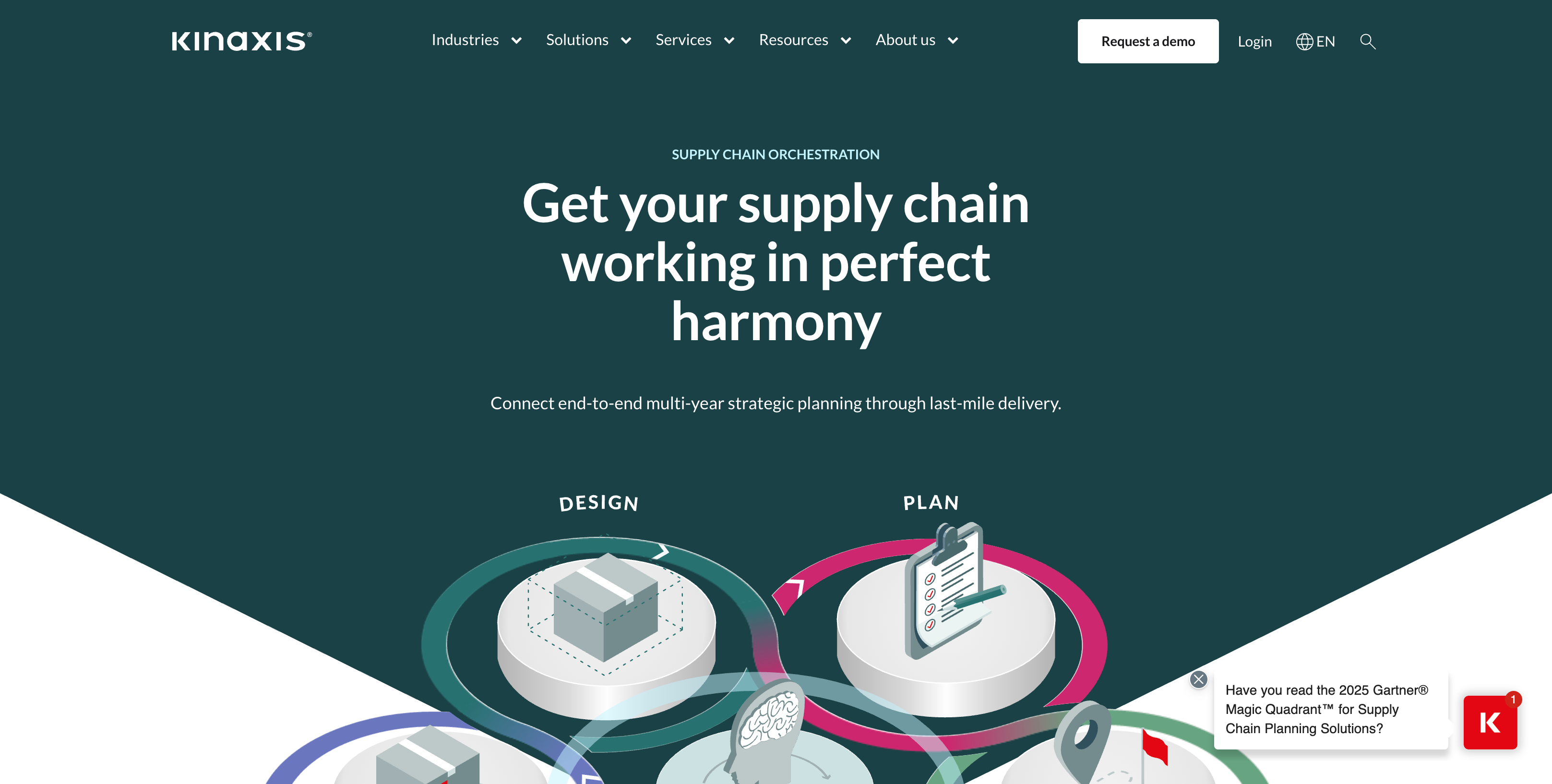
It stands out for its planning solutions, end-to-end visibility and the ability to simulate scenarios to anticipate and respond quickly to changes in demand, interruptions or variations in supply. Kinaxis also automates key processes, optimizes inventories and facilitates collaborative decision-making.
The price of Kinaxis is not public and a quote is needed with the sales team to know the price for your company, as it may vary depending on the size of the company, number of users and modules contracted. However, it is possible to request a free demo through their official website.
Key features of Kinaxis
- Collaborative planning: Kinaxis makes it easier for all teams to work by aligning it on a single platform, giving visibility to the different phases of the supply chain and streamlining decision-making.
- End-to-end visibility: It centralizes information on suppliers and inventories, allowing to detect bottlenecks and anticipate interruptions before they impact the business.
- Simulation and scenario analysis: It offers a virtual “laboratory” where you can model different demand hypotheses, routes and suppliers, quantify their impacts and choose the best strategy before implementing it.
- Automation and optimization with AI and Machine Learning: It uses intelligent engines that learn from historical and real-time data to refine demand forecasts, adjust stock levels and generate actionable recommendations, all with automatic data ingestion and natural language queries.
- Cloud-based: Kinaxis' infrastructure is cloud-based, allowing it to scale according to the company's needs and specific requirements.
Intuitive interface and customizable dashboards: Kinaxis, like other tools, offers data visualization in intuitive graphics, easy to read and use by non-expert personnel.
Disadvantages
- Learning curve and need for training: The flexibility and breadth of functionality can be complex for new users, requiring specialized training and internal resources to exploit its full potential.
- Implementation and support costs: It is a solution aimed primarily at large companies, so the initial investment, the cost of licenses and support can be high for SMEs.
- Data quality dependency: The effectiveness of the platform depends on the quality and consistency of the input data. Incomplete or incorrect data can affect forecasting accuracy and decision-making
Is Kinaxis the best supply chain collaboration system for your company?
Kinaxis Supply Chain Collaboration is especially recommended for:
- Large companies and multinationals: Organizations with complex supply chains, global operations and multiple business partners that require real-time visibility and coordination.
- Organizations with high variability and volatility in demand: Companies that need to simulate scenarios, optimize inventories and plan collaboratively to minimize risks and costs.
Please note that Kinaxis is not recommended for:
- SMEs with tight budgets, where the cost of subscription and implementation may be excessive.
- Simple or low-volume logistics operations, which do not require such advanced analytical or predictive capabilities.
- Companies without IT equipment or experience in complex solutions, since Kinaxis needs specialized resources and ongoing training.
- Projects that require rapid and “ready to use” deployments.
Coupa supply chain collaboration software
Coupa is an AI-based platform that specializes in supply chain optimization, purchasing processes, and managing enterprise purchasing processes. It stands out for its Supply Chain Collaboration cloud suite, which connects buyers, suppliers and 3PLs in a single digital flow to synchronize forecasts, inventories and shipments in real time.
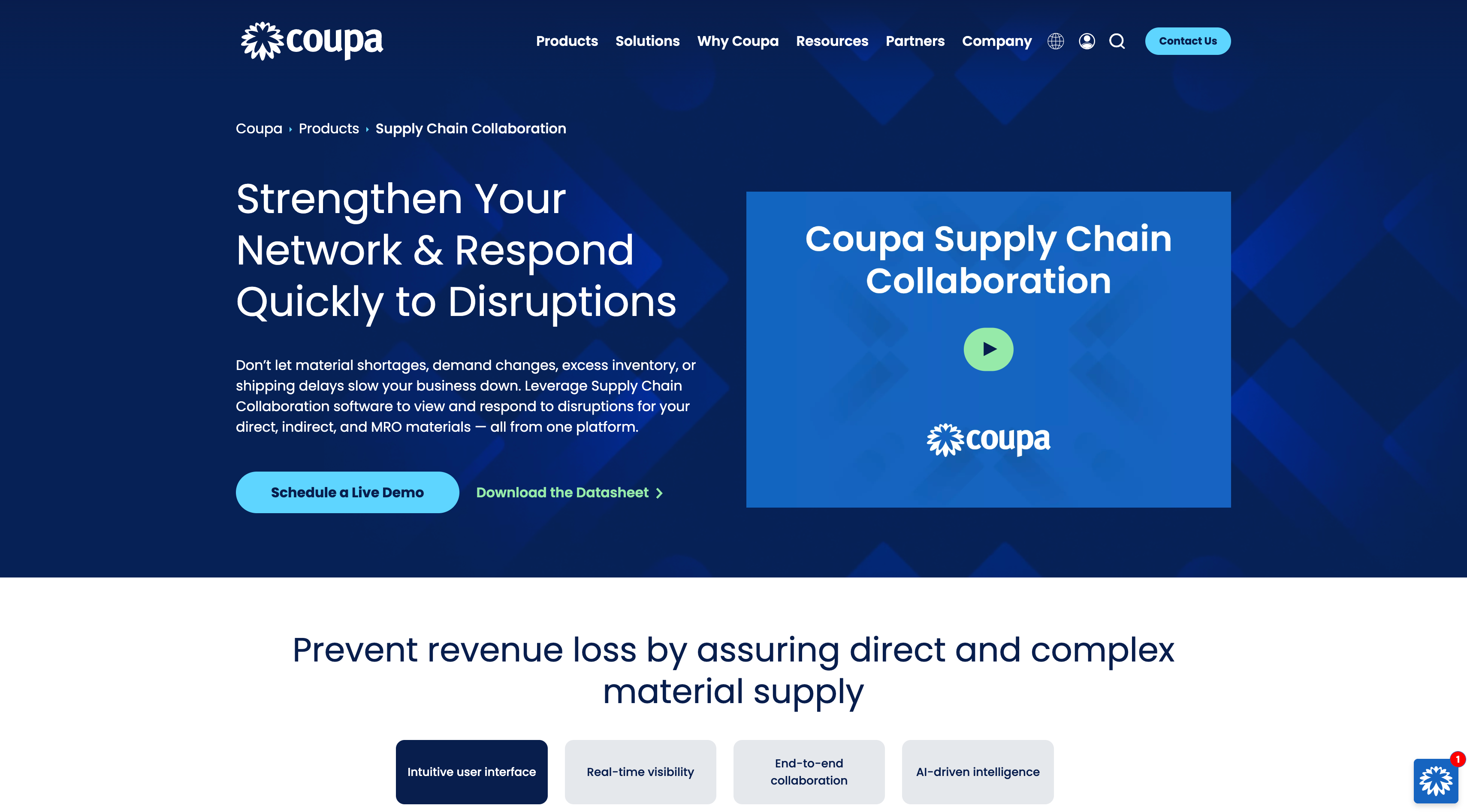
The price of Coupa is not public. Coupa is billed annually and depends on the number of transactions and the number of users that operate the tool.
Benefits and Capabilities of Coupa Supply Chain Collaboration
- Real-time collaboration: It facilitates the exchange between buyers and sellers, through its centralized portal. This helps accelerate joint decisions, negotiations between teams, and issue resolution.
- Comprehensive end-to-end visibility: It monitors every link in the supply chain in real time, orders, inventory and billing, allowing you to anticipate risks, reduce costs and make more strategic decisions.
- Multi-ERP integration and scalability: With native integration capability with systems such as SAP, Oracle and Netsuite, Coupa adapts to complex business environments.
- Advanced analytics with AI: Incorporates artificial intelligence to analyze supplier performance, detect trends and anticipate interruptions in the supply chain.
- User Experience and Adoption: Its intuitive, cloud-native interface facilitates rapid adoption for technical and non-technical teams.
What your users are saying:
“I have been using Coups for almost 3 years. It's very easy to use. It's intuitively implemented and integrates with other tools.” Coupa customer, 2024.
“Coupa is an extremely robust platform that will help you consolidate and take your business to the next level. Its P2P system is very easy to use and customizable.” Coupa customer, 2024.
Limitations and disadvantages
- Data quality dependency: The effectiveness of Coupa depends on the information uploaded (orders, inventories, billing, catalogs) being complete and accurate. Errors or inconsistencies can cause visibility issues and incorrect decisions.
- Learning curve and customization complexity: Advanced configuration is often cumbersome for teams without tool experience, requiring extra support and greater IT involvement.
- Long implementation time for large companies: Although Coupa is highly customizable, the implementation time with large companies is often long and the implementation complicated.
- High costs and orientation to large companies: Coupa is mainly aimed at medium and large companies, with a subscription and licensing model that can be costly for SMEs or companies with limited budgets.
- Persistent manual processes in specific cases: Despite automation, there may be situations where loading, validating or reconciling information must be done manually, adding administrative burden.
What your customers are saying:
“Although Coupa is generally intuitive, some areas, in particular those related to configuration and backend configuration, can be complex and require significant administrative training or vendor support. Flexibility in workflows and approval chains is powerful, but it can be cumbersome if not properly managed, especially in large organizations with tiered approval processes.” Coupa customer, 2024.
“Implementing Coupa in global or large companies can be complex and time-consuming. Coupa is highly configurable, but not easily customizable beyond its standard framework” Coupa customer, 2024.
Is Coupa the best supply chain collaboration software for your company?
Coupa is one of the leading collaboration platforms for the supply chain, recognized by analysts such as Forrester for its strategic vision, advanced integration capabilities and innovation in AI. It's ideal for companies that:
- It coordinates orders, inventories and suppliers in multiple countries and needs a single view in real time.
- You want to automate end‑to‑end flows and work on the same portal with each business partner.
- It seeks resilience and scale: Coupa connects to one of the largest B2B networks in the market, facilitating the on-boarding of new suppliers without friction.
However, if your company is small, has very specific processes or limited resources for implementation and support, there are simpler or more affordable options on the market. Coupa stands out in environments where scale, global standardization and the need for advanced digitalization are a priority.
Oracle supply chain collaboration software
Oracle Supply Chain Collaboration is a cloud functionality that allows companies to plan, coordinate and execute supply chain processes. Its main objective is to optimize collaboration between areas to streamline the supply chain, making it more adaptable and resilient. Oracle stands out for providing automation of the entire supply chain process, complete visibility of the operational process, and AI-based forecasts.
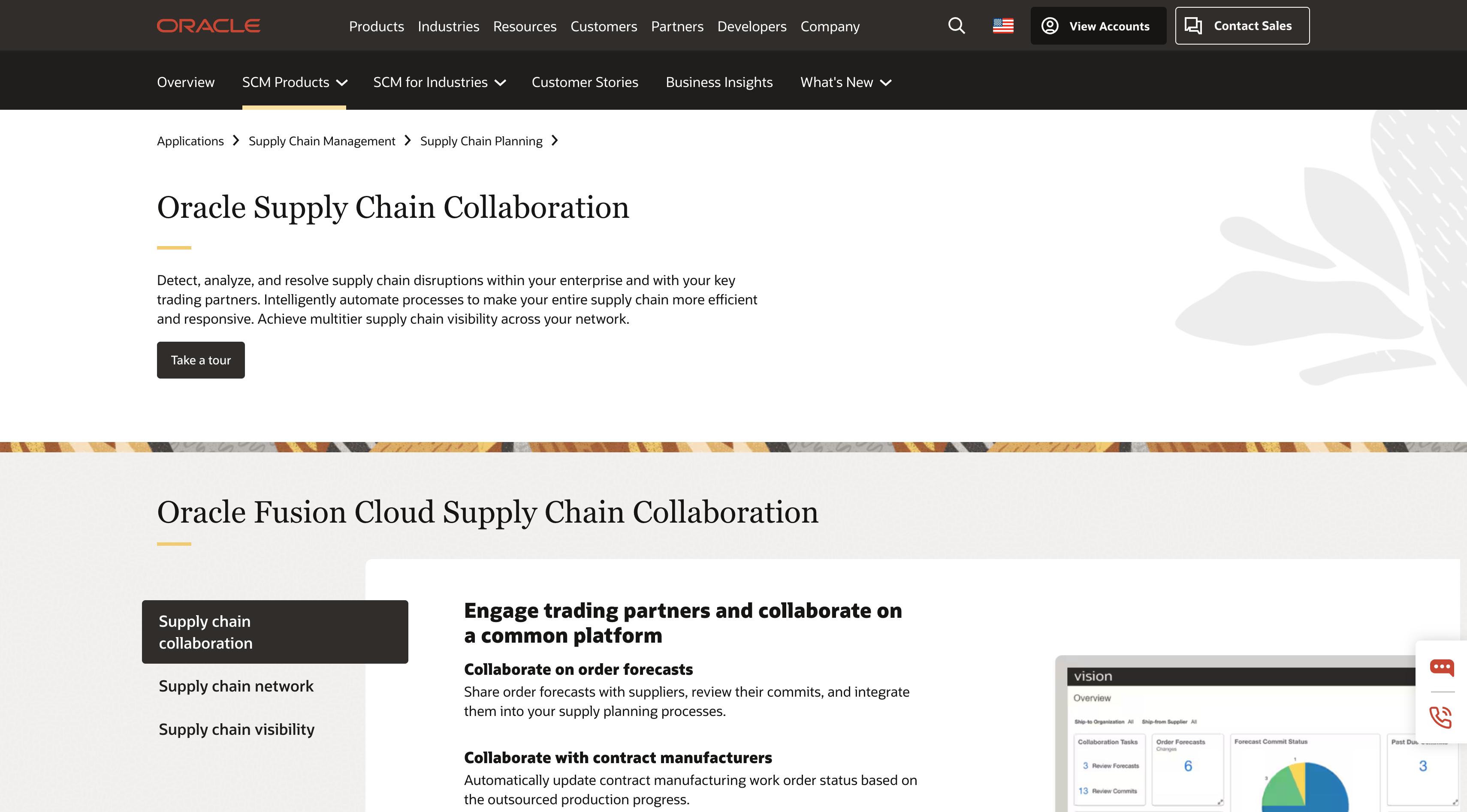
The price of Oracle is on a subscription basis and is not public, it varies depending on the number of users, modules purchased, functionalities implemented and integration needs of each company.
Oracle Features and Benefits
- Collaboration with suppliers: Oracle allows you to plan demand and also adjust communication with suppliers to know their capacity and commitment to planning.
- Vendor Managed Inventory (VMI): Suppliers can have access to sourcing information to plan their production and delivery based on that.
- Collaboration in external manufacturing: Centralizes visibility over the progress of orders, use of materials and production in contract manufacturers' plants, improving coordination and time compliance.
- Process and communication automation: Automates the upload and validation of data through web portals, B2B messaging and web services, eliminating manual processes and reducing administrative errors.
- Collaborative reporting and analysis: Facilitates the extraction of data and generation of shared reports between the key areas involved to facilitate decision-making.
- Integration with multiple ERPs: Supports the connection with various business systems to centralize information and improve multi-entity collaboration.
What your customers are saying:
“It's a first-rate planning tool. It allows you to adapt quickly to changes in demand. This helps reduce the storage of goods and items in inventory, thus improving manufacturing efficiency.” Oracle customer, 2021.
“The information provided is useful but can be improved, the pages are not as intuitive” Oracle Customer, 2022.
Disadvantages and limitations
- Needs training: Advanced configuration requires more training and experience, which leads to the need for specialized technical personnel.
- High cost: The pricing model is subscription-based and per user, but actual costs depend on the number of users, contracted modules and level of integration; investment can be high for SMEs or smaller scale projects.
- The data must be of quality: The reliability of automated processes depends on the correct and complete load of information; in addition to having data of at least 2 years to make the forecasts correctly.
- User experience: Some users have commented on problems with the user experience, and that it's not as friendly in configurable environments.
- Deployment time: Complex implementations can take weeks or months, especially if adaptation to very specific internal processes is necessary.
What your customers are saying:
“The graphics and page integration aren't that good.” Oracle Customer, 2022.
“The main disadvantage of this implementation is that the Oracle SCM configuration and customization method is not simple or easy to use. Another disadvantage of Oracle SCM cloud software, due to the poor connection, is that we can't transfer all our files, videos, recordings, and other information. In addition, the Oracle SCM platform cannot generate a real content repository to quickly access the relevant data resources needed to prepare sales proposals” Oracle Customer, 2020.
Is Oracle the best supply chain collaboration software for your company?
Oracle is often an option for large companies and multinationals with complex supply chains. Its strength lies in multitier collaboration, end-to-end visibility and the ability to customize processes to any industrial sector.
Oracle is ideal if your company:
- It operates on a global scale, with many suppliers and logistical complexity.
- It requires high automation, advanced analysis and real-time collaboration.
- It plans to integrate heterogeneous systems and take advantage of AI/analytics technologies.
- It has resources for comprehensive implementation and training.
However, you should consider:
- High ownership costs: If your company has very specific processes and needs to adopt an automation tool, you shouldn't ignore the cost and return on investment.
- Learning curve: not being one of the simplest tools on the market, you should take into account the learning curve, which is likely to be solved with extra training.
- The decision depends on the scope of your operations, your logistics digitalization objectives and the available budget.
Blue Yonder supply chain collaboration software
Blue Yonder is a solution for global supply chain collaboration and optimization. It is especially popular with large companies, retailers and manufacturers that have a complex operation and are developed in multi-markets.
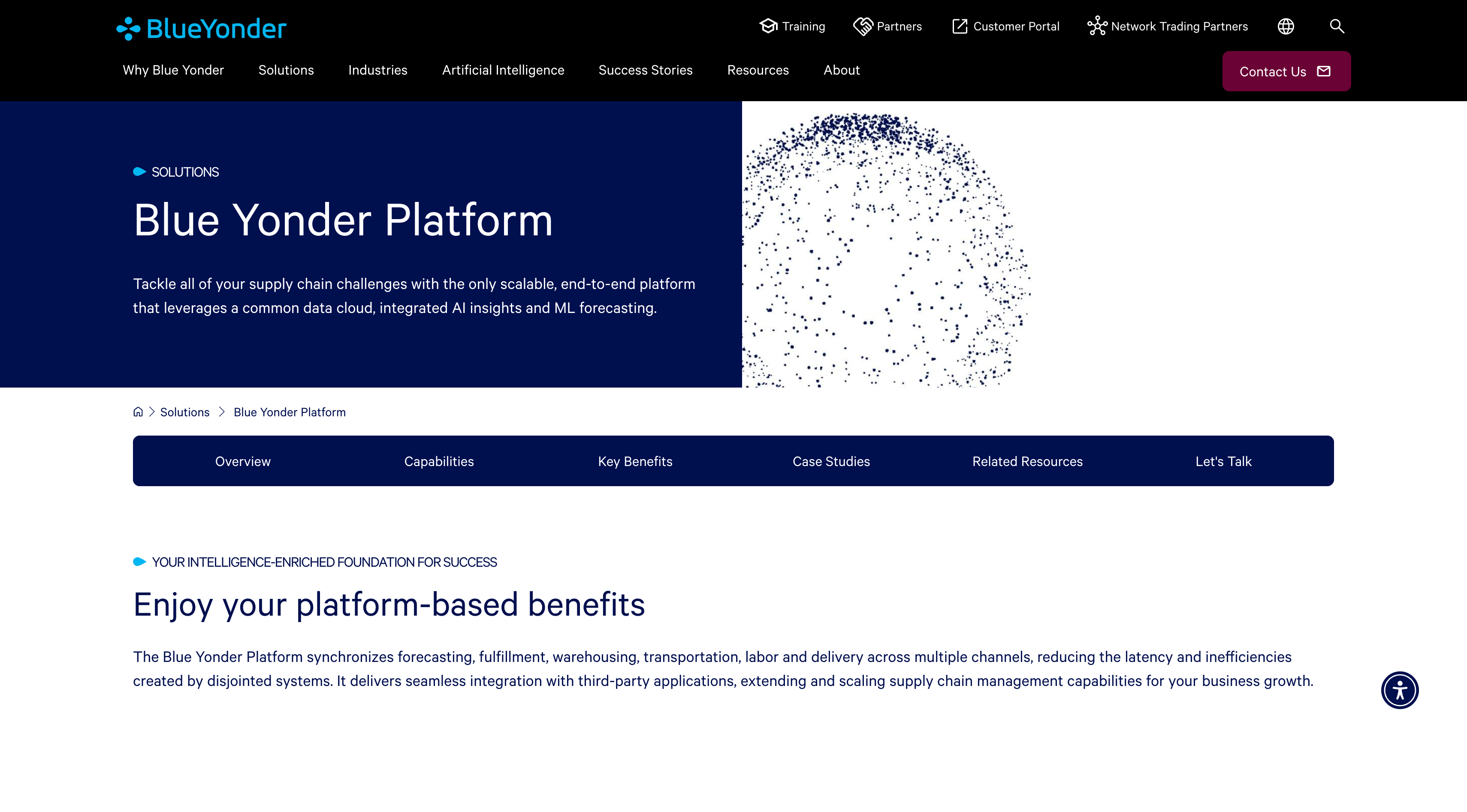
It stands out integrates because it technologies such as artificial intelligence, machine learning, automation, predictive analysis and real-time visibility into a single cloud suite.
Blue Yonder doesn't have a standard fixed price for its supply chain collaboration software, as the cost depends on several factors such as company size, number of users, contracted modules, and scope of implementation. If you need a free trial, you can get one by contacting the Blue Yonder team.
Blue Yonder Features and Benefits
- End-to-end supply chain collaboration and visibility: In Blue Yonder you can monitor inventories, orders, and deliveries of the entire chain. It allows collaboration between different areas to align demand planning decisions.
- Unified planning (demand & supply): Combines demand and supply planning in a single process, allowing inventories, resources and purchases to be adjusted simultaneously.
- Predictive analytics with AI: Uses AI and machine learning to forecast demand, identify risks, recommend actions and proactively adjust the entire chain to any disruption.
- Cloud scalability: When operating in the cloud, one of its advantages is scalability if you have large amounts of data as you use the tool.
- Support for multiple sectors: He specializes in industries such as retail, consumer goods, automotive, 3PL/logistics, healthcare, advanced manufacturing and high technology.
Disadvantages and limitations
- Sloped learning curve: It is an enterprise-level solution, with advanced capabilities that require training and experience for daily implementation and management.
- Cost for Enterprise: Its pricing model usually starts at $100,000 USD per year and is mainly aimed at large organizations; it can be costly and excessive for SMEs.
- Support and performance: Some users have reported slow processes, and slow support response.
Is Blue Yonder the best supply chain collaboration software for your company?
Blue Yonder is currently one of the most powerful and sophisticated options for companies looking for real-time collaboration, full visibility and predictive optimization in complex, global supply chains. It's ideal for:
- Large and multinational corporations in retail, consumer goods, logistics and advanced manufacturing.
- Organizations with high demand for omnichannel and multi-company collaboration.
- Those that prioritize automation, waste reduction and resilience to market disruptions.
It may not be the best option if your company:
- It is small or medium-sized with simple operations or low budget.
- Look for a tool that is quick to implement and easy to use without much customization.
- You're looking for a tool that doesn't have a steep learning curve or needs a lot of staff training sessions.
Conclusion
Choosing Supply Chain Collaboration software goes beyond seeing prices and comparing functionalities, it is a process in which you must take into account the particularities of your company and choose the one that best suits your needs. Here's a short summary by software so you can choose your own:
- Datup is the best solution for supply chain teams that value precision, ease of use and speed of implementation and that bill at least USD 10M.
- SAP Supply Chain Collaboration is ideal for those companies with a global supply chain and multiple partners, high volume of operations and transactions.
- Relex: is recommended for large, multichannel supply chains, which need to automate their collaborative Supply Chain operations with AI and also consider environmental factors in their operations.
- Kinaxis: it is ideal for large companies and multinationals with global chains, multiple partners and the need for visibility and coordination in real time.
- Coupa is perfect when you need to coordinate orders, inventories and suppliers in multiple regions. In addition, it facilitates end‑to‑end automation and offers resilience and scale.
- Oracle: recommended for companies with complex operations that require advanced automation and real-time analysis with AI; ideal when you have resources for implementation and training.
- Blue Yonder: It is ideal for large corporations and multinationals in retail, mass consumption, logistics and advanced manufacturing; for organizations with high demand for omnichannel and multi-company collaboration; and for those seeking to automate processes.





